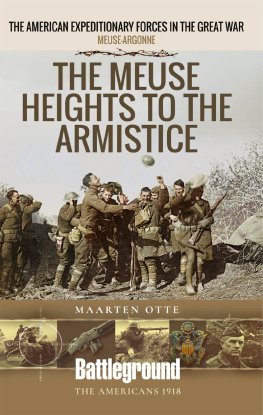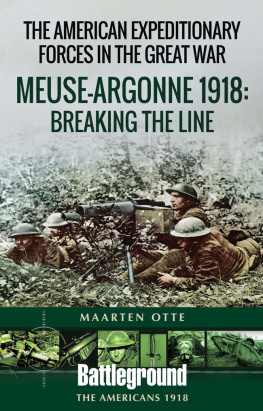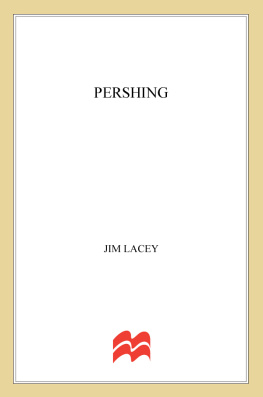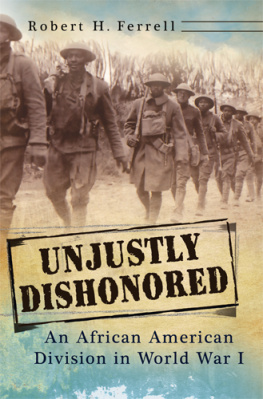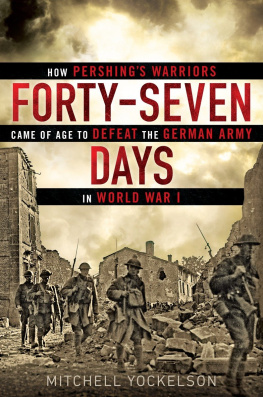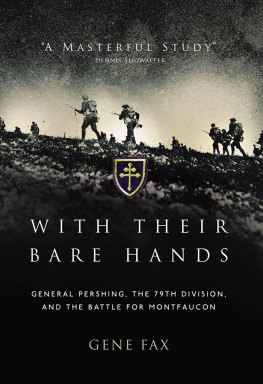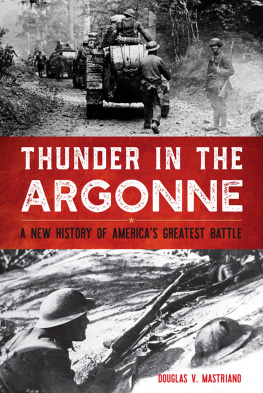2007 by the University Press of Kansas
All rights reserved
Published by the University Press of Kansas (Lawrence, Kansas 66045), which was organized by the Kansas Board of Regents and is operated and funded by Emporia State University, Fort Hays State University, Kansas State University, Pittsburg State University, the University of Kansas, and Wichita State University
Library of Congress Cataloging-in-Publication Data
Ferrell, Robert H.
Americas deadliest battle : Meuse-Argonne, 1918 / Robert H. Ferrell.
p. cm. (Modern war studies) Includes bibliographical references and index.
ISBN 978-0-7006-1857-6 (pbk. : alk. paper)
ISBN 978-0-7006-2463-8 (ebook)
1. Argonne, Battle of the, France, 1918.
2. United States. ArmyHistoryWorld War, 19141918. 3. World War, 19141918CampaignsMeuse River Valley. I. Title.
D545.A63F477 2007
940.436dc22
2006029077
British Library Cataloguing-in-Publication Data is available.
Printed in the United States of America
10 9 8 7 6 5 4 3
The paper used in this publication is recycled and contains 30 percent postconsumer waste. It is acid free and meets the minimum requirements of the American National Standard for Permanence of Paper for Printed Library Materials Z39.48-1992.
In reading history... we must remember that the orders of the practical, two-fisted soldiers, interpreted long afterwards by an anemic professor of history, form a picture very different from the actual facts.
Major General George Van Horn Moseley, One Soldiers Journey
PREFACE AND ACKNOWLEDGMENTS
As the twenty-first century progresses, the last veterans of World War I are passing from the scene. In 2006, perhaps twenty remained of the nearly 4 million Americans in the army and the half a million in the navy in 19171918. Their numbers were considerable until the 1970s and 1980s, but today, these veterans are all centenarians, and in a year or two they will be gone.
World War I has been largely forgotten. People today know little about it; they have no idea what issues caused the European war in 1914 or how it turned into a world war with the United States entrance in 1917. They have little understanding of the nations experience in the war, and the individual engagements have entered the dark corridors of history.
In the fashion of present-day historical writing, I suspect I will be criticized for writing about a single battle, even if it was the largest one of the warthe Meuse-Argonne, which lasted for forty-seven days, from September 26 to November 11, 1918. It will seem too small a subject, lacking the expansiveness that historical writing is expected to embody. My fellow historians consider military history old-fashioned. But surely World War I was the root of the horrendous eventsin terms of lives lostof the twentieth century and, by extension, the twenty-first. World War II, the cold war, and terrorism can be traced to the war of 19141918, leading to events that in earlier times (notably, the nineteenth century) would have been unimaginable.
In World War I, the appearance of a huge American army in France was decisive, and in that armys history, the most important battle was the Meuse-Argonne. Although that battle was a success, the cost in human casualties was high, which is my reason for writing about it. There were 26,277 men killed and 95,786 wounded, making it the deadliest battle in all of American history. It also was the largest, with 1.2 million men at the front. Still, the battle has received little attention for many years. The only book on the subject, Our Greatest Battle , by military historian Frederick Palmer, was published in 1919.
I am greatly indebted to historians of Americas participation in World War I. Some years ago, Edward M. Coffman published a remarkably accurate and well-written account of what he described as, in the phrase of the Wilson era, the war to end all wars. Donald Smythes two-volume biography of General John J. Pershing stands as a beacon in the literature of American military history. Similarly valuable are Allen R. Milletts biography of General Robert L. Bullard and Forrest C. Pogues biography of General George C. Marshall. General James L. Collins Jr. presided over the U.S. Armys Center of Military History for years and edited General Marshalls manuscript on the American Expeditionary Forces. Through books and lectures, Russell F. Weigley almost single-handedly created interest in military history among the officers and men who made it; a whole generation of U.S. Army historians owes a great deal to Weigley. David F. Trask has also contributed significantly to the scholarship, both military and civil, about World War I. In addition, James J. Cooke has written division and topical histories, John S. D. Eisenhower has a notable general account, and Alfred F. Hurley is the biographer of General William Mitchell. And all students who seek to write about the United States in 19171918 must thank a new generation of scholars typified by Carol Byerly, Mark E. Grotelueschen, Kenneth E. Hamburger, Jennifer D. Keene, Timothy D. Nenninger, and James W. Rainey.
My thanks to Jeffrey M. Flowers of the Manuscript Division of the Library of Congress; Timothy Nenninger and Mitchell A. Yockelson of the Modern Military Branch of the National Archives; and Richard J. Sommers, David A. Keough, and Richard Baker of the U.S. Army Military History Institute, which is part of the Army War College in Carlisle Barracks, Carlisle, Pennsylvania.
Maps of the Lost Battalion were drawn by John M. Hollingsworth. Betty J. Bradbury was the skilled word processor.
My appreciation to the staff of the University Press of Kansas, notably Linda Lotz, who copyedited the manuscript; Susan Schott and Larisa Martin; and especially director Fred M. Woodward, who has turned Kansas into a powerhouse among university presses. He has been a friend for twenty years and, on occasion, an acutely wise counselor. In the case of this book, he provided its title and, more than that, made it better by pointing out literary errors and logical mistakes along the way.







